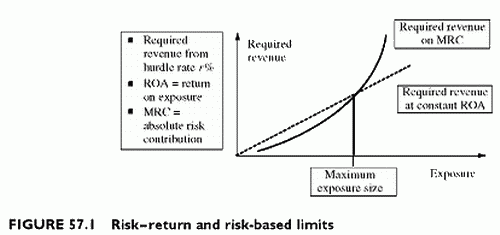RISK-BASED LIMITS
Category: Risk Management in Banking
We consider a two-segment portfolio, with two exposures: A is an existing exposure, and B is a new exposure of varying size. We examine what happens in terms of return on economic capital when the additional B exposure increases, while its AIS in percentage or, equivalently, its Return on Assets (ROA) remains constant.
A number of simplifying assumptions help without loss of generality. The exposure of A remains constant and equal to 50; the exposure of B is initially 10 and progressively increases; A and B share the same default probability 1% and the same zero recovery rate; the risk of A and B are independent; the percentage AIS or ROA remains constant at 1%; regulatory capital is 4% of exposure; the required return on capital, economic or regulatory, is 25% pre-tax; the loss volatilities, both standalone and marginal, are used as a proxy for economic capital.
We first check that the 1% ROA provides an AIS in line with the target return of A using regulatory capital. For A, the AIS is 1% x 50 = 0.5, the regulatory capital is 4% x 50 = 2, and the ratio AIS/capital is 0.5/2 = 25%. The AIS of B is usually proportional to exposure. It would here be 1% x exposure, resulting in a return to regulatory capital of 1%/ 4% = 25%, since regulatory capital is 4% of exposure.
Instead of referring to the contractual AIS, we now look at what it should be when Bs exposure increases, using a target return on economic capital of 25%. The required AIS is no longer proportional to exposure because economic capital is not. We simulate the behaviour of the required AIS of B based on a target return on marginal risk contribution to the portfolio loss volatility, when the exposure of B increases.
If the exposure of B is 10, we first derive its marginal contribution to the portfolio volatility. Since the default probabilities are 1%, the standalone unit loss volatilities are s/d x (1 — d) = Vl% x 99% = 9.950%. Accordingly, the standalone loss volatilities of A and B are respectively 50 x 9.950% = 4.975 and 9.950% x 10 = 0.995. Since risks are independent, the portfolio loss volatility is the square root of the portfolio variance, which sums up the standalone variances. The sum of variances is 24.750 + 0.990 = 25.740 and the portfolio loss volatility is the square root, or 5.074. The initial portfolio volatility with A only was 4.975. The incremental loss volatility due to B is the difference 5.074 — 4.975 = 0.099. By contrast, the additional regulatory capital due to B is 10 x 4% = 0.04. It is much lower than its marginal risk contribution.
Now, we increase the size of Bs exposure up to 50 and calculate again its marginal risk contribution and its incremental regulatory capital. The new standalone loss volatility of B becomes 50 x 9.95% = 4.975, identical to that of A because exposures share the same characteristics. The portfolio loss variance 24.750 + 24.750 = 49.50 under independence of risks, and the portfolio loss volatility increases to V49.50 = 7.036. The marginal risk contribution to volatility is now 7.036 — 4.975 = 2.061. The marginal regulatory capital is only 4% x 50 = 2. We observe that the marginal risk contribution now gets higher than the marginal capital, whether it was lower when the exposure of B was only 10 or not.
The required AIS on marginal risk contribution is 25% x 2.061 = 0.515, while it is still 25% x 2 = 0.5 for regulatory capital. Conversely, the effective return on marginal risk contribution at the 1% AIS is 1% x 50 = 0.5 and the return on risk contribution is 0.5/2.061 = 24.264%, now lower than the current 0.5/2 = 25% on regulatory capital. The size of 50 is very close to the break-even value at which the new exposure fails to meet the target return on economic capital when we stick to a contractual ROA of 1%. Trying a higher size would confirm this finding, the constant 1% ROA providing a decreasing return on economic capital, while maintaining the 25% on regulatory capital. This break-even value is the risk-based limit.
The underlying reason for the existence of this economic limit is that economic capital increases more than proportionally to exposure, while the ROA remains constant. The purpose of this analysis is to demonstrate that setting limits has a purely economic rationale.
In Figure 57.1, the required return as a percentage of exposure based on marginal risk contribution grows with size. The return on exposure (or ROA%) is a constant, implying that revenues grow proportionally with exposure. It is at least above or equal to the minimum return required on capital. There is an optimal size for the transaction since the ROA no longer compensates the additional risk contribution beyond a certain size.
Other reasons, such as the size of the exposure relative to the borrowing capacity of the obligor, limit the size per obligor. The economic rationale provides a basis for setting limits, when no other constraint is binding.
For instance, when doubling the exposure, from 50 up to 100, the absolute risk contribution to loss volatility increases from around 5 up to around 15, or three times as much. Hence, the risk-reward profile deteriorates when Bs exposure increases.

